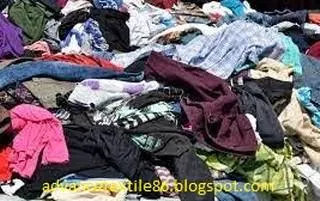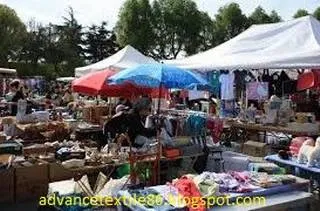Textile recycling
Textile
recycling is the
process of recovering fiber, yarn, or fabric and reprocessing textile components
into useful products. Textile waste products are collected from a variety of
sources and then sorted and processed based on their condition, composition, and
resale quality. The end result of this processing may vary in new articles of
clothing, starting from the production of energy and chemicals.
Due
to excessive use in global fashion culture and the recent trend of waste generation,
textile recycling has become the main focus of global sustainability
efforts. Globalization has led to a fast fashion trend where many consumers
consider clothing to be disposable due to rising prices. The development of
recyclable technology has allowed the textile industry to produce huge amounts
of products that deplete natural resources. Textile recycling strategies
have been developed to address this increase in textile waste and new solutions
are still being studied. Recently, some apparel retailers have embraced this
recycling effort and are now publicly advertising products made of recycled
textile materials as well as changing customer expectations.
Textile recycling method
Mechanical process
Mechanical
processing is the most widely used technique for recycling textiles. Companies
in the United States use about 7.6 million bales of cotton to make textiles
weighing 500 pounds per bale. The cotton can be recycled mechanically after
separating them from different materials. However, some plants can still process
recycled materials that are not made of pure cotton such as 98% cotton and 2%
spandex. After initial sorting, the raw material is further sorted by color to
avoid re-dying and bleaching. Once done, the textile components are cut and separated
into fibers. At the moment the final product is not yet usable and needs to be
aligned before spinning. This process is known as carding. Since recycled
cotton fibers are inferior and inferior, the fibers are now cut with a few
virgin cotton fibers. Another common material used in mechanical processing is
polyester. With this process, the recyclable materials are plastic bottles, not
polyester textiles. Both are produced from the same material called
polyethylene terephthalate. When materials are sent to the facility, they are
first sorted by color and type. Like cotton, PET plastic is cut into pieces and
washed to remove contaminants. The dried, cut plastic is spread in PET pellets
and left to extrude to form new fibers.
Chemical process
Chemical
processing is commonly applied to synthetic fibers like polyethylene
terephthalate because these fibers can undergo the breakdown and decomposition
process. This process has not yet been widely used, but there are some
organizations that are applying research and chemical recycling. Large and
small production sites are Eco Circle, Worn Again, Avron, and Ion cell. In the
case of polyethylene terephthalate, the initial materials are first divided
into monomers. This is done using chemicals that facilitate glycolysis,
methanolysis, hydrolysis, or aminolysis. This work of depolymerization also
removes contaminants from the primary material like colored and unwanted
fibers. From here, the material is polymerized to be used in the production of
textile products. In contrast to the mechanical method of recycling, the
chemical recycled used produces high-quality fibers such as virgin fiber.
Therefore, no new fibers are required to support the product of the chemical
process. Different chemicals and pathways are used for other materials such as
nylon and cellulose-based fibers, but the overall structure of the process is
the same.
Textile recycling process
Sorting/picking
When
recycling post-consumer textile waste, the picking process represents the
pyramid model in terms of material volume. At the beginning of the pyramid -
and the largest volume - are crude picks, then second-hand garment exports,
conversions into new products, cloth wiping, and smoothing, landfill burning for
energy, and finally diamonds. It is commonly found in pyramid models that the
quantity of clothing items is inversely proportional to its financial value,
moreover, it means that they are the most profitable even though diamonds are
made in the smallest sector (1-2%) of the selection process.
Crude
sorting
In
unrefined sorting, waste items are manually segregated into separate sections
while bulkier items like coats and blankets are removed. Textile waste
categories can be divided based on clothing items such as material, condition,
quality, or shirt. Employees with the highest efficiency perform the most
detailed-based distinctions such as being able to distinguish cashmere from
wool by touch. Along with the crude sorting process, recyclable textiles are
also graded to represent their commercial quality based on different fiber
properties as a unit of length, color, and chemical composition.
Second-hand
garment export markets
Second-hand
garment exports are a growing global market; Based on a single report, the
market price has doubled between 2007 and 2012. Export trends are generally
seen in developing countries, ranging from the West, or among disaster relief
recipients, with the United States accounting for 45% of total Western exports.
In Africa in particular, Western clothing is a high product that imports $61.7
million in sales annually and these exports to sub-Saharan Africa account for
more than a third of the total clothing purchased.
Converting
textile goods into new products
Clothing items that cannot be resold can be converted into new products using recyclable fibers. The two main results of this process are shoddy and mungo. Shoddy refers to one of the historical examples of textile recycling and making yarn products from old materials. Panipat is one of the largest producers of coarse yarn with more than 300 mills in northern India, mostly used for weaving blankets. Munger was invented after the invention period and refers to the process of using textile clippings during the making of wool which is exported to most European countries due to the need for fur in the cooling temperature and flammability regulations. Specific examples of products made using fun or mungo include luxury Italian blankets, fiber in US dollars, and sustainable fashion trends.
Advantages of textile recycling
Some
of the advantages of textile recycling are as follows-
i.
Recycled textiles provide low-cost clothing.
ii.
Keeping used textiles out of waste reduces government disposal costs.
iii.
Less energy is expended during processing.
iv.
Protecting the planet for future generations.
v.
Textiles save recyclable energy and reduce pollution.
vi.
Recycling provides benefits both environmentally and economically.
vii.
Textiles reduce pressure on recyclable new resources.
viii. Textiles reduce the demand for recyclable dyes and fixing agents.










0 Comments